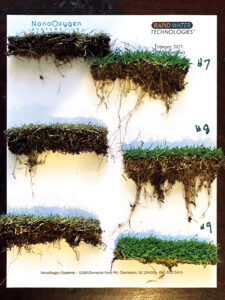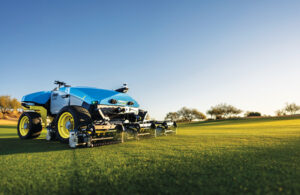We share three high-tech tools that address turf management challenges and could be game-changers for your golf course.
The post Three high-tech tools that could be game-changers for your course first appeared on Golfdom.
Golf course superintendents must manage an always-evolving landscape of challenges. The good news is that advancements in irrigation technology, data management, autonomy and artificial intelligence are revolutionizing turf management.
These innovations aren’t just bells and whistles. They’re powerful tools that optimize resource use, minimize environmental impact and proactively mitigate pest and disease outbreaks while empowering superintendents to become more effective stewards of the game.
Here are three cutting-edge turf management technologies to get acquainted with. They address difficult turf challenges while improving a course’s long-term health, sustainability and playability.
Nicholas Dolimpio had a major turf problem. His course’s roots were so shallow that the turf slid off the greens.
“We never were able to grow roots,” explains Dolimpio, the director of golf course maintenance and grounds at Lake Nona Golf and Country Club in Orlando. “So, when we’d roll the greens, the turf would slide over the cup. It was bad.”
As the home course for nearly 30 pro golfers, Dolimpio faces immense pressure to maintain elite playing conditions at the 18-hole championship Tom Fazio course. As a band-aid, he would fertilize and manage greens by overseeding them.

Ultra fine bubbles helped save Nicholas Dolimpio’s greens at Lake Nona G&CC, by promoting root growth. (Photo: NanoOxygen Systems)
“(The roots) would go down (further into the soil) and just die,” he says. “We created a detriment every year when we overseeded. We’d put seed down and a ton of water down right after the wet season when the bermuda didn’t need to search for water, so it wasn’t trying to push roots.”
Dolimpio had long suspected the well water he used to irrigate the golf course was the culprit, so he tested it.
“The baseline is 4 parts per million (ppm) dissolved oxygen. It’s what is required to sustain life,” he says. “When we pulled water from our well, it was 3 ppm.”
In comparison, rainwater is between 7 and 8 ppm, which accounts for the sudden green flush commonly seen in turf after a rainstorm. This deficit prevents beneficial aerobic microbes from surviving, and harmful anaerobic bacteria run wild in the oxygen-depleted soil. This is a surefire formula for poor-quality, unhealthy turf.
Dolimpio was familiar with Ron Pote and NanoOxygen Systems, which engineers both portable and permanent water improvement systems and specializes in installing and controlling oxygen-rich ultra fine bubbles in irrigation water.
According to Pote, ultra fine bubbles are microscopic gas bubbles less than 200 nanometers in size. For reference, a strand of human hair is about 80,000 nanometers wide. Unlike larger bubbles that float to the surface and release gas, ultra fine bubbles are non-buoyant and stay suspended in water. This allows them to deliver oxygen throughout the water column.
These bubbles can be made from air or directly from oxygen, nitrogen or carbon dioxide and have applications in various industries, like golf turf, Pote says. In turf, ultra fine bubbles increase oxygen levels in the soil, which benefits plant root growth, improves access to nutrition and contributes to better overall health. Pote prefers the standard term “ultra fine bubbles” to correctly describe the bubbles in this process, although “nanobubbles” is the term most often used in casual conversation.
“We can take basic groundwater or well water, which has nearly zero dissolved oxygen, and raise it to 15 to 20 ppm, which is two times the amount found in rainwater. That’s the magic” Pote says.
Seeing is believing
Since using the NanoOxygen System to enrich and treat his irrigation water, Dolimpio has witnessed the ultra fine bubble’s magic firsthand on his course.
Dolimpio references the rainwater green-up when describing the ultra fine bubbles’ impact on Lake Nona’s turf. However, he adds that he doesn’t observe this occurrence anymore.
“You always used to see a little green up after it rains,” he explains. “We don’t see that anymore because our water has more dissolved oxygen than rainwater. We don’t notice the green up because (the turf) is always green.”
Dolimpio says Lake Nona’s turf has rebounded and playing conditions have improved exponentially. For example, when the El Nino conditions cleared out this spring, and the Orlando region began experiencing warmer, dry afternoons, Dolimpio didn’t irrigate as frequently to keep the turf looking healthy. In the spring, he attempted to let the ryegrass they’d overseeded die back to encourage the bermuda roots to dive deep to pull water.
“We’ve been able to firm up the golf course far beyond what we’ve ever been able to do before,” he explains. “It’s pretty amazing. And even in the spots where we’ve had complete wilt of the overseed in the past, the bermuda is not batting an eye. It’s pulling water from where it should be, and that’s all due to the roots doing what they’re supposed to, which is driving deep. Now they’re not being killed by anaerobic bacteria and (oxygen-depleted) conditions.
“In the past, with a fully overseeded golf course, if we’re not cognizant about taking care of the bermuda (when the ryegrass dies off) and getting it set in, then our rough is essentially dirt,” Dolimpio continues. “Today, we’re probably 50/50 bermuda to ryegrass when typically, this time of year, we’d still be at 20/80 ryegrass to bermuda. So, (the NanoOxygen System) helps us get back to a better golf course quicker. Our main goal is to get a better product for the summer, and I believe this system is helping us get (the course) on that track.”
In addition, introducing ultra fine bubbles directly into the soil profile reduces dependence on heavy synthetic fertilizers, a stark contrast to past practices that relied on them to achieve and sustain a vibrant green color.
“This is going to allow us to move to a much more organic route,” Dolimpio says. “In the past, that didn’t give us the results we were looking for because the soil wasn’t healthy and lacked the (beneficial) microorganisms to break that fertilizer down.”
NanoOxygen System has also integrated an ozone injection system, which is controlled by monitoring the water’s oxidation-reduction potential (ORP). This method is commonly employed to gauge disinfection effectiveness, and in this application, Pote says the small amount of ozone sufficiently eradicates turf pathogens like pythium, water molds and cyanobacteria.
Lastly, NanoOxygen Systems provides courses using an active online monitoring system. Pote says this continuously checks water quality and provides superintendents instantaneous feedback via cellular and cloud-based systems.
On the horizon, Pote anticipates adding carbon dioxide with oxygen and ozone to produce carbonic nano bubble acid to reduce irrigation water pH to optimal growth levels. He also wants to include more automation to optimize system performance and develop a modular system that can be placed near a shoreline or at the irrigation pump and set to operate independently.
Pote has become somewhat of an ultra fine bubble evangelist, preaching the benefits of oxygenated water to turf managers. He believes a lot of education still needs to be done to bring the industry up to speed about the positive impact of ultra fine bubbles on turf and soil health.
“I think we’re opening people’s eyes to at least monitor the dissolved oxygen in their water,” Pote says. “And if it’s not high enough, now you can do something about it.”
Meet your new mowing technician. They show up for work every day and never complain. They maintain an impeccable edge line while flawlessly executing complex striping patterns for less than $20 per acre. They just need the occasional jolt of power and an escort to the next fairway — at least for now.
This spring, Salt Lake City-based Firefly Automatix began delivery on its AMP fairway mower. Once programmed, this fully automated, full-sized electric fairway mower requires little supervision.
While initially conceived as a harvester for the sod industry, it didn’t take long for Firefly engineers to see the potential as an autonomous electric mower for golf course fairways and sports fields. Three years ago, Firefly engineers began working on a dedicated mowing machine that utilizes battery power, programmable autonomous operating software and servo-electric actuation in lieu of hydraulics, which makes it more efficient, faster, and smoother to deliver a quality cut.

Robotic mowers — like the AMP Fairway Mower from Firefly Automatix (pictured) — could soon be a permanent fixture on golf courses nationwide. (Photo: Firefly Automatix)
“We did a lot of research on what equipment was available in the golf mowing industry, and we saw some pretty significant opportunities to improve that equipment in terms of not only efficiency but durability, noise and (operational) pollution and operating without (petroleum-based) fuel and hydraulics,” says Mark LeBlanc, senior design engineer and product manager.
In a nutshell, here’s how Firefly’s technology works. During the initial deployment stage, a Firefly tech assists in setting up a machine, which is equipped with a stand-on platform to operate it manually.
With the assistance of a tablet app, the operator surveys the area to be mowed, driving the perimeter of a fairway while the mower’s onboard GPS logs where the edges of those fairways exist. At the same time, other obstacles — bunkers and ponds — are identified as exclusion zones. Once compiled, the mower is ready to operate independently, only requiring a human’s assistance to drive it to the next fairway.
LeBlanc is working on software upgrades that will allow the AMP — provided there are no obstacles — to transport itself to the next fairway.
Once a fairway is programmed into the system, the AMP can mow various paths while maintaining a precise line within 3 cm and a max overlap of 3 inches.
“We’ve got a lot of functionality built into (the software) that allows a superintendent to plan different pattern types, change the mow angles, choose the number of cleanup passes, and how much overlap you want,” LeBlanc says. “We’re going to keep introducing features, like 50/50 patterns, to give superintendents more functionality on how they want their course mowed.”
An added feature is that the AMP still functions manually if the GPS goes down.
“We designed it to be easy to move on,” LeBlanc says. “Even with the stand-on platform, it’s comfortable to ride and easy to turn and maintain straight lines. That’s a pretty big differentiator.”
The AMP unit costs around $160,000, but, LeBlanc explains, it gives superintendents a compelling value proposition over traditional fairway mowers. The run time on a charge enables 10-12 hours of mowing, making a 100-inch cut, which converts to 20-25 acres of turf or around 6 acres per hour — depending on the grade and how the mower was programmed to cut.
LeBlanc estimates that the AMP capital expenditures are around $4.98 per acre compared to a traditional 100-inch fairway mower to mow a single acre of grass, considering that Firefly built the AMP to be a 10,000-hour machine. Running on electricity, energy costs are around $.53 an acre, and labor costs about $1.04 an acre. Finally, maintenance costs are estimated at $.19 an acre.
Putting it to work
Jeff Miller, director of agronomy at San Diego’s The Santaluz Club, an 18-hole championship Rees Jones-designed golf course, has long believed in the potential of autonomous mowing equipment on golf courses. An early adopter of autonomous rough mowers, when he heard about Firefly’s AMP, he knew he needed to demo it.
Miller had been disappointed by other autonomous mowers, which featured technology built upon existing platforms. Firefly designed the AMP from the ground up, resulting in the mower’s weight being more evenly distributed and balanced.
In addition to zero hydraulics and near-silent running, the AMP was all-wheel drive. Each wheel features its own dedicated motor that can be controlled digitally, providing impressive traction and maneuverability.
“When we did our demo, it was pouring rain, and there was standing water (on the course),” he recalls. “The AMP handled the slopes and the terrain like a champ. I was pretty surprised by the ability to make softer turns and whip around the course with so much control in those conditions.”
It wasn’t long before Miller had three AMPs on order.
“I’m definitely going to be more efficient,” he says. “I have days where we don’t have any dew, and it’s really hard to see lines, especially if there’s not a lot of growth. It’s going to be the same cut in the direction I want, which is very beneficial.”
Superintendent Matthew Gourlay has experienced both sides of the industry’s water dilemma firsthand.
Gourlay’s previous course, the public 27-hole Colbert Hills Golf Course in Manhattan, Kan., had to pay for its water, so efficient and responsible water use was paramount.
In his current role managing turf at Hillcrest Country Club in Boise, Idaho, he focuses on maintaining course conditions that meet his membership’s expectations and delivering a high-quality playing experience.
“The courses couldn’t have been more different,” he says.

“The actionable info allows supers to dial in individual run times based on a day’s readings,” says TerraRad Tech CEO Derek Houtz. (Photo: TerraRad Tech)
In both cases, Gourlay relied on Zurich, Switzerland-based TerraRad Tech’s turfRad soil moisture sensing system. This system is designed to help golf course superintendents optimize their irrigation use. It takes detailed soil moisture measurements and creates high-resolution maps that guide turf managers in adjusting for even watering, reducing waste and improving course conditions.
“At (Colbert Hills), our goal was to figure out how much moisture was on the fairways and how far we could potentially push them compared to just visually looking at them and doing some random soil sensor measurements,” Gourlay says. “And then at (Hillcrest), we are looking for firm and fast conditions. (Players) feel the golf course played soft, and I was seeking a communication tool to show them that it may not be because of moisture. Instead, it could be because of organic matter or maybe other underlying soil issues.”
While the turfRad technology is complex, its application is relatively simple. An L-band microwave radiometry sensor is mounted to the back of a fairway unit. Every time that unit mows, it collects moisture data from throughout the golf course. Along with integrated GPS, the sensor collects roughly 10,000 soil moisture measurements during 20 minutes of mowing. A high-res moisture map and statistics on individual irrigation heads are generated for the superintendent, which allows them to dial down and analyze an area about 1.5 yards by 4 inches deep.
“Many superintendents have stuck a time domain reflectometry probe in at one point and measured maybe one foot or a yard over and see a variability of up to 10 to 12 percent within that small scale,” says Derek Houtz, TerraRad Tech CEO, an aerospace engineer with a background in microwave remote sensing and environmental monitoring. “But by taking this larger soil volume with our remote sensor, you smooth out those small-scale variabilities to give you a better view of what can really be controlled by an irrigation head.”
TurfRad gives supers the ability to optimally place water and adjust irrigation run times to create uniform conditions, says Houtz.
The newfound knowledge will be instrumental at Hillcrest, allowing Gourlay to provide members with a clearer picture of root-zone moisture levels and their implications.
“Instead of dealing with feelings, we have hard numbers, which give us a starting point to understand soil moisture and the potential moisture content that is out there,” he says.
The post Three high-tech tools that could be game-changers for your course first appeared on Golfdom.